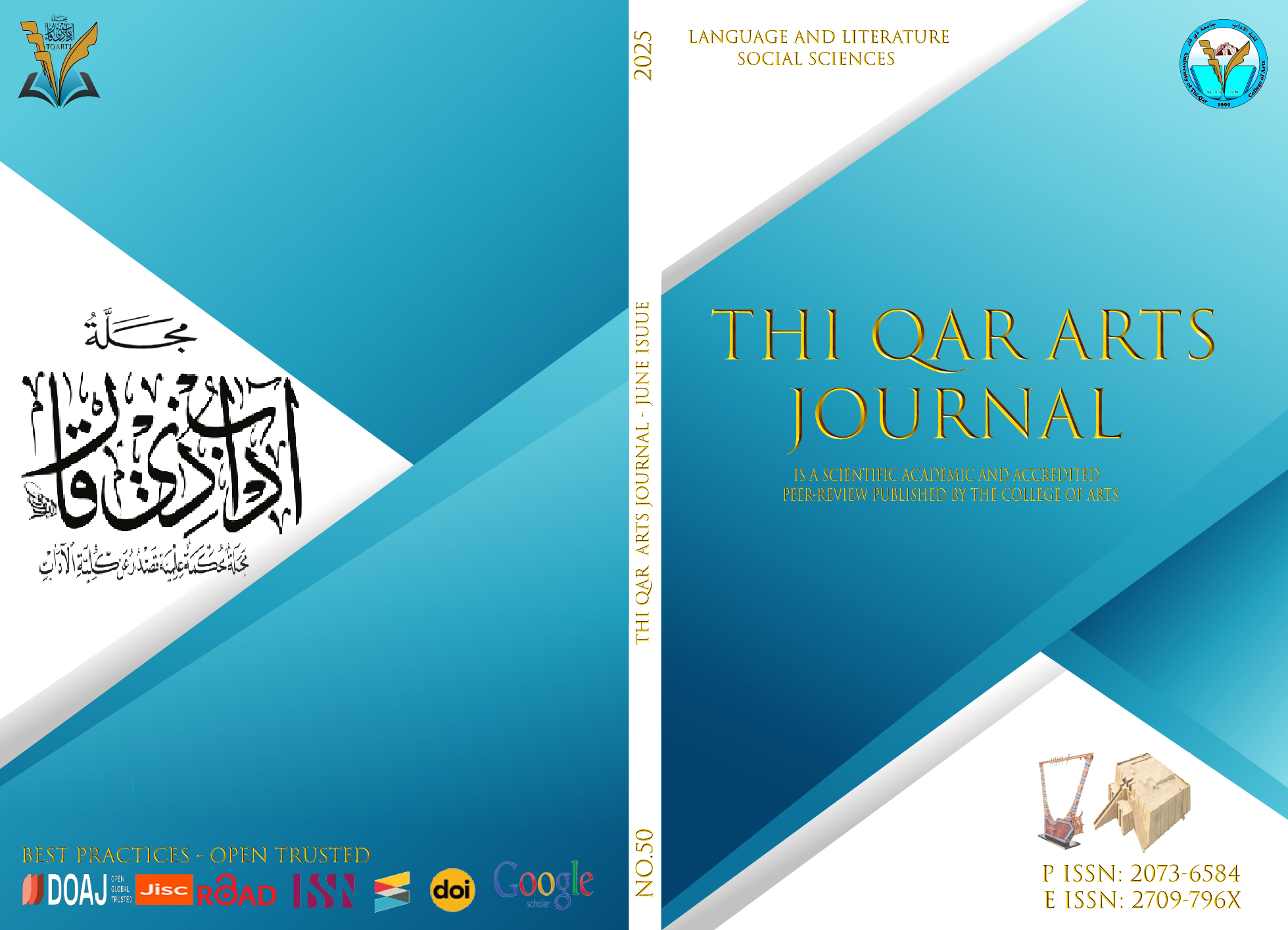The Structure of Rhythm in Prose Poetry: The Experience of Ammar Al-Masoudi in "Brown Summer" (A Model)
DOI:
https://doi.org/10.32792/tqartj.v4i50.785Keywords:
Random Selection, Imposing Theory, Prose Poetry, Rhythm, Fragmentary Reading.Abstract
This paper sheds light on an exciting experience related to rhythm in prose poetry. It specifically addresses the rhythm in prose texts to show how it can be exciting, distinctive, and innovative, and how this rhythm contributes to revealing the creative structure of the prose text. The study concluded with several results that clarify the main characteristics of the prose text, such as rhythmic totality, rhythmic cohesion, and rhythmic differences.
There is a tradition observed by those interested in archiving Arabic poetry, where the text precedes the theory, suggesting creativity first, and then the theory frames it. However, this research, with the experience of rhythm in prose poetry by Ammar Al-Masoudi, faced a reversed equation. The text by Ammar Al-Masoudi invoked traditional rhetorical theory with a modern spirit that disrupted the stable and calm at the same time.
This harmonious approach caught my attention, so I decided to read its rhythmic structure, taking the collection "Brown Summer" as a sample to reveal its procedural truth. The research roadmap was divided into two sections. The first section focused on two points: the first on the rhythm of prose poetry and its outcomes, while the other outlined the theoretical features of the experience by linking the poet's previous experiences with the selected experience.
The second section was a field for application by randomly selecting samples from the collection to ensure objectivity and avoid the error of imposing theory on the text.
Adopting this vision in approaching the rhythm of prose poetry, we tried to deviate from the usual academic studies and not read the "Brown Summer" experience by dividing its rhythm into partial elements such as repetition and parallelism, and then searching for evidence of them in the experience. Instead, we followed the method of random selection of a single sample that represents the entire poem experience for us. This will avoid falling into fragmentary reading that does not care about the overall experience and only focuses on the part. Moreover, it will help us pursue the rhythmic meaning in the single experience, reinforcing the principle that prose poetry is a personal experience.
Random selection will avoid the problem of forcibly imposing theorization on the read text, as we said. Through this, we will not come with preconceived judgments, but our reading will be subject to the specifics of the read experiences, which this research aims to achieve.
Downloads
References
1. Rhythm of Arabic Poetry in Classical, Free Verse, and Prose Poetry, Dr. Naaman Abdul-Sami Metwally, Dar Al-Ilm wal-Iman for Publishing and Distribution, Egypt, 2013.
2. Rhythm in Modern Poetry: An Applied Study on the Collections of Farouk Shousha, Ibrahim Abu Senna, Hassan Taleb, and Rifaat Salam, Dr. Muhammad Salman, Dar Al-Ilm wal-Iman for Publishing and Distribution, Alexandria, 1st edition, 2008.
3. The Aesthetics of Prose Poetry, Suzanne Bernard, translated by Dr. Zuhair Majid Maghames, Al-Funun Press, Baghdad, 1986.
4. Butterfly Dream: Internal Rhythm and Textual Characteristics in Prose Poetry, Dr. Hatem Al-Sakr, Ministry of Culture and Tourism, Republic of Yemen, 2004.
5. Arabic Rhetoric: Another Reading, Dr. Muhammad Abdul-Muttalib, Egyptian International Publishing Company - Longman, Dar Nubar for Printing, 2nd edition, 2007.
6. Brown Summer, Ammar Al-Masoudi, Dar Al-Shu'un Al-Thaqafiya Al-Aama - Baghdad, 2024.
7. On Prose Poetry, Ali Ahmad Said (Adonis), Shi'r Magazine, Issue 14, 1960: 0-81; and Afuq.
8. Modernity and Modern Style: A Study in the Modernity of Shi'r Magazine, Structure and Project, Sami Mahdi, Dar Al-Shu'un Al-Thaqafiya, Baghdad, 1988.
9. Modern Arabic Poem: Sensitivity of the First Poetic Emergence, Generation of Pioneers and the Sixties, Dr. Muhammad Saber Ubaid, Alam Al-Kutub Al-Hadith, Irbid - Jordan, 2nd edition, 2010.
10. Prose Poetry and Transformations of Arabic Poetics, Dr. Mahmoud Ibrahim Al-Daba, International Printing Company, Cairo, 1st edition, 2003.
11. What the Attribute Does Not Convey, Dr. Hatem Al-Sakr, research presented to the tenth Al-Marbad Poetry Festival, Dar Al-Hurriya for Printing, Baghdad, 1989.
12. The Ecstasy of Experimentation in the Jurisprudence of Ecstasy - A Reading in the Transformations of Writing by Al-Masoudi (2007-2020), Dr. Sabah Al-Tamimi, Al-Zawraa Newspaper, Issue 7662, February 14, 2022.
Published
Issue
Section
License
Copyright (c) 2025 د. جميل صاحب جليل

This work is licensed under a Creative Commons Attribution 4.0 International License.
The journal applies the license of CC BY (a Creative Commons Attribution International license). This license allows authors to keep ownership of the copyright of their papers. But this license permits any user to download, print out, extract, reuse, archive, and distribute the article, so long as appropriate credit is given to the authors and the source of the work. The license ensures that the article will be available as widely as possible and that the article can be included in any scientific archive.



















